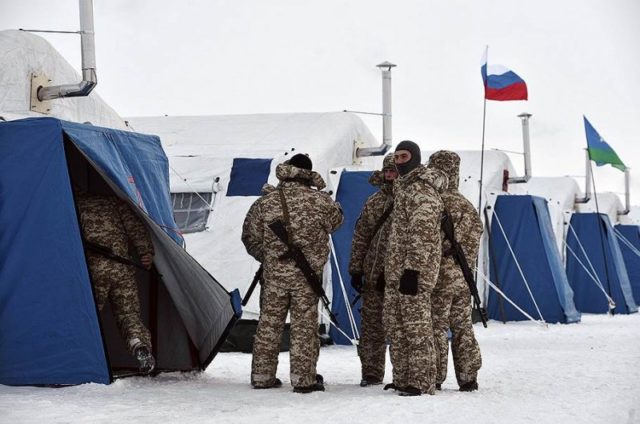
Completing the Arctic Shield: Russian Activities on Wrangel Island
Publication: Eurasia Daily Monitor Volume: 17 Issue: 48
By:

On February 11, the head of the Russian Ministry of Emergency Situations, Yevgeny Zinichev, stated that a series of Crisis Management Centers were being established in the Artic region in order to “increase the level of security in the Northern Sea Route” (Lenta.ru, February 11). This initiative logically flows from Russia’s recently adopted strategy for the region, primarily concerned with increasing its posture in the High North by beefing up local infrastructure and increasing local military potential (Lenta.ru, December 24, 2018; see EDM, March 16, 2020).
The strategy is premised on two main objectives: pursuit of Arctic-based natural resources (secondary role in light of the present oil market price turbulence) and the determination to secure unilateral control over the Northern Sea Route (NSR), which runs along Russia’s polar coast. The NSR makes up a key element of the longer Northeast Passage, in recent years promoted by Beijing as the “Polar Silk Road, which aims to connect Chinese producers with European markets via the Bering Strait. This strategic shipping artery is being positioned as a shorter alternative to the sea route through the Suez Canal. To secure the NSR, Moscow plans to complete six military bases in the High North—on the New Siberian Islands, Alexandra Land, the Severnaya Zemlya archipelago, Novaya Zemlya (Rogachevo), Mys Shmidta and Wrangel Island—thereby creating a multi-layered defensive shield. Widespread opinion posits that the military facilities on the New Siberian Islands and Alexandra Land—frequently nicknamed the “Russian guards” of the Arctic (TASS, December 2, 2019)—are the most crucial elements of this constellation. And yet, the vitality of Wrangel Island should not be downplayed. Aside from its proximity to the United States, this is the first major island encountered on the westward Asia–Europe maritime transit route after crossing through the Bering Strait.
Wrangel Island has historically (as early as 1911) played an instrumental role in enabling Russian/Soviet military domination of the region. In 1924, the Soviets demonstrated a “military icebreaker” prototype to ward off claims on this island by the United States (Geopolitica.ru, August 20, 2014). After 1991, Russia’s regional presence (including military) was dramatically reduced (Izvestia, July 2, 2014). However, as its Arctic policy began to shift during the mid-2000s, Moscow adopted a much more assertive stance. This was primarily reflected in the rapid development of military infrastructure in the Eastern Military District (MD) by 2014. For example, that year, the authorities established a military town (voyenniy gorodok) on Wrangel Island, effectively restoring Soviet military potential in the area by deploying radio-location units, anti-missile/aircraft formations and a spare airfield, which had been liquidated in 1992 (RIA Novosti, October 22, 2014).
Starting from 2016, Russia further intensified its militarization of Wrangel Island by locally deploying the Sopka-2 S-band Air-Route Radar Complex (ARRC). As stated at the time by the head of the press-service of the Eastern MD, Alexander Gordeev, the deployment of the Sopka-2 was designed to secure Russia’s control over aerial targets moving in the area (Politros.com, November 4, 2016). The official webpage of the Sopka-2 ARRC manufacturer states that this unique radar is primarily designed to detect/control air traffic and to monitor the local airspace. More specific functions include the ability to detect various air objects; provide measurements of range, azimuth and elevation angle (height) of targets; as well as identify the target’s country of origin.
The Sopka-2 consists of three radars: a primary radar that uses a passive phased-array antenna, and two secondary radars whose antennas are mounted at the back of the phased array. It also has Monopulse Secondary Surveillance Radar (MSSR), which considerably increases its qualities and operational capabilities (Lemz.ru, accessed March 31). The radar can spot objects at a maximum range of 450 kilometers, with merely one technical operator, who can actually operate the system remotely. Importantly (particularly in the harsh climatic conditions of the High North), the Sopka-2 can operate in high wind (up to 40 meters per second) and extreme cold (down to –50 Celsius) (Zvezdaweekly.ru, January 4, 2019). During 2017–2018, the Russian side conducted a series of trainings/exercises on Wrangel Island specifically concerned with testing the radar’s ability to locate simulated enemy aerial objects (of a conditional enemy) as well as locate individual objects moving within a larger group (Politros.com, October 28, 2018).
In 2019, training intensified (carried out twice that year) and gained in sophistication and scope. During this period, the Sopka-2 complex was primarily used to locate aircraft or aerial objects equipped with stealth (low observable) technology (Tvzvezda.ru, November 15, 2019). Another important development observed during these trainings was an emphasis on locating smaller targets, such as unmanned aerial vehicles (UAV), operating individually and in groups/swarms to perform reconnaissance missions (Defendingrussia.ru, March 13, 2019).
The beginning of this year witnessed several new developments that included exercises involving troops assembled from the Eastern MD, with specialists of the Radio-Technical Troops (RTT) allocated a special role. During these drills, RTT specialists used the Sopka-2 ARRC to simulate tracking enemy flying objects operating with their transponders switched off. Information acquired by the radar was immediately sent to the commanding post of the anti-missile/aircraft defense post. To complicate the task, the “enemy” aerial vehicles were constantly changing direction and speed (Mil.ru, March 18, 2020).
Russia’s prime objective in beefing up its military capabilities in the Arctic region—in terms of both firepower and creating a multi-layered defense—is to secure full control over the NSR. This maritime Arctic route is seen by Russian authorities as a source of substantial economic gains as well as a means for Moscow to promulgate the “Great Eurasian Power” concept. The ongoing developments on Wrangel Island attest to this reality. For now, Russian actions are concerned with mainly defensive tasks, reflecting growing uneasiness about other countries (primarily the US) attempting to increase their presence in the region (Zvezdaweekly.ru, August 29, 2019), which the Kremlin perceives as a direct challenge to Russia’s position in its High North.



